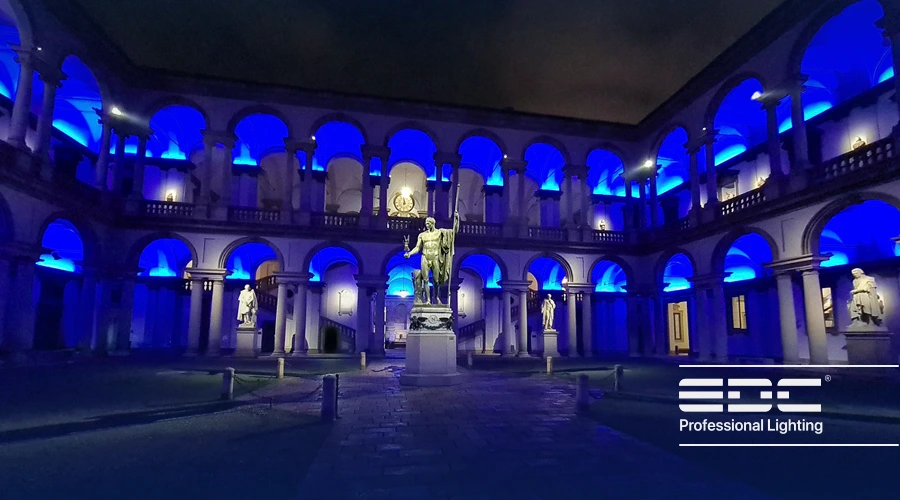Spot lighting is a lighting technique in which light is focused and focused on a specific area or object to draw more attention to it. Spot lighting is commonly used in interior spaces such as homes, art galleries, stores, and theaters to highlight specific details and features of the environment or objects. Some lights are very suitable for creating spot lighting; because they can direct light precisely to the desired location. In this article from EDC, after examining the features and introducing this technique, suitable lights for spot lighting are also introduced.
Spot lighting and its benefits
Spot lighting, as the name suggests, is a type of lighting that focuses on illuminating a specific area or object. This type of lighting is in contrast to ambient or general lighting, which is responsible for illuminating the entire space. In general, the main purpose of this technique is to highlight specific features of the environment or objects in a space.
The benefits of spot lighting include the following:
Draw attention to specific details: Spot lighting can focus on specific elements such as artwork, architecture, or specific decorations and draw the viewer’s attention to these details.
Increase visual appeal: Using spot lighting, you can add more appeal and depth to interior spaces and make the environment more beautiful and pleasant.
Improve functionality: Spot lighting can be used in spaces such as the kitchen, work desk, or study, providing appropriate and sufficient lighting for specific activities.
Create distinction: This type of lighting can be used to create distinction and emphasize specific areas of the space, such as illuminating walkways or living areas.
Energy saving: Using spot lighting, you can illuminate only specific areas instead of lighting the entire space, which can help save energy.
Difference between spot lighting and accent and decorative lighting

Spot lighting focuses on specific points or objects to draw more attention to them, such as lighting a work of art or a bookcase.
Accent lighting is used to highlight specific features or elements of the decor, such as using track lights to highlight stone walls or architectural columns.
In contrast, decorative lighting is used more for aesthetic purposes and to create attractive visual effects, such as using colored and decorative lights to create a pleasant and beautiful atmosphere in the environment.
What decorations is spot lighting used for?
Spot lighting can be used in types of interior decoration lighting, including:
Modern decoration: In modern decoration, smooth and simple lines and neutral colors are used to implement modern lighting. Spot lighting can add a sense of depth and dimension to this type of decoration and double the beauty of decorative objects.
Classic decoration: This decoration uses delicate details and decorations and warm colors for classic lighting. Local lighting can add a sense of grandeur to this type of decoration and make antique objects stand out more.
Minimal decoration: To implement minimalist lighting, few objects and decorations are used. Local lighting can focus on objects in this type of decoration and make them the focal point of the space.
Rustic decoration: In rustic decoration, natural materials such as wood and stone are used. Local lighting can add a sense of warmth and intimacy to this type of decoration and showcase the beauty of the texture of natural materials.
Application of local lighting in different spaces
Local lighting has a variety of applications in different spaces and can be used for different purposes.
Local lighting in the home

Living room: To highlight furniture, artwork, or a fireplace
Kitchen: To illuminate under cabinets, a kitchen island, or a workspace
Bedroom: To create a relaxing, soothing space for reading, working, or spending quiet time before bed.
Bathroom: To illuminate a mirror, vanity, or bathtub
Hallway: To create a safe space
In commercial spaces

Stores: To highlight products, display cases or shelves
Restaurants: To create a cozy and intimate atmosphere
Museums: To highlight works of art or historical objects
Office: To illuminate desks, shelves or meeting spaces
Using outdoor spot lighting

Garden and grounds: To illuminate paths, steps or sculptures
Pool: To create an attractive atmosphere
Facade: To highlight specific elements of the building facade
Lights suitable for local lighting
Local lighting can be used in various spaces, including public and outdoor spaces such as parks, gardens, squares and streets. In the table below, we have introduced the recommended lights for each space.
| Desired space | Suggested lights |
| Reception |
|
| Kitchen and bathroom |
|
| Art exhibitions |
|
| Park |
|
| Exterior view of the building |
|
Tips for choosing the right lamp for task lighting
For task lighting, look for lamps with medium to high brightness (around 2,000 to 5,000 lumens).
Choose a lamp that is adjustable so you can adjust the direction and intensity of the light, which will allow you to focus the light precisely on your desired target.
Use a light controller to adjust the intensity of the light and create a space that suits your needs, this will make it easy to adjust the brightness and avoid wasting energy.
Look for lamps with low energy consumption to save on your electricity costs. LED lamps are the best choice for task lighting because they use very little energy and have a long lifespan.
You can contact the EDC sales department to purchase a variety of high-quality lighting products.